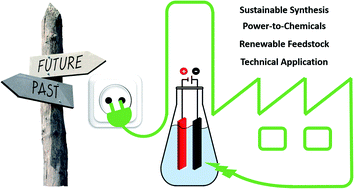Electro-organic synthesis – a 21st century technique
Abstract
The severe limitations of fossil fuels and finite resources influence the scientific community to reconsider chemical synthesis and establish sustainable techniques. Several promising methods have emerged, and electro-organic conversion has attracted particular attention from international academia and industry as an environmentally benign and cost-effective technique. The easy application, precise control, and safe conversion of substrates with intermediates only accessible by this method reveal novel pathways in synthetic organic chemistry. The popularity of electricity as a reagent is accompanied by the feasible conversion of bio-based feedstocks to limit the carbon footprint. Several milestones have been achieved in electro-organic conversion at rapid frequency, which have opened up various perspectives for forthcoming processes.

- This article is part of the themed collections: Most popular 2019-2020 review articles, Editor’s Choice – Ning Jiao, 2020 Chemical Science HOT Article Collection and New reactivity in organic chemistry


 Please wait while we load your content...
Please wait while we load your content...